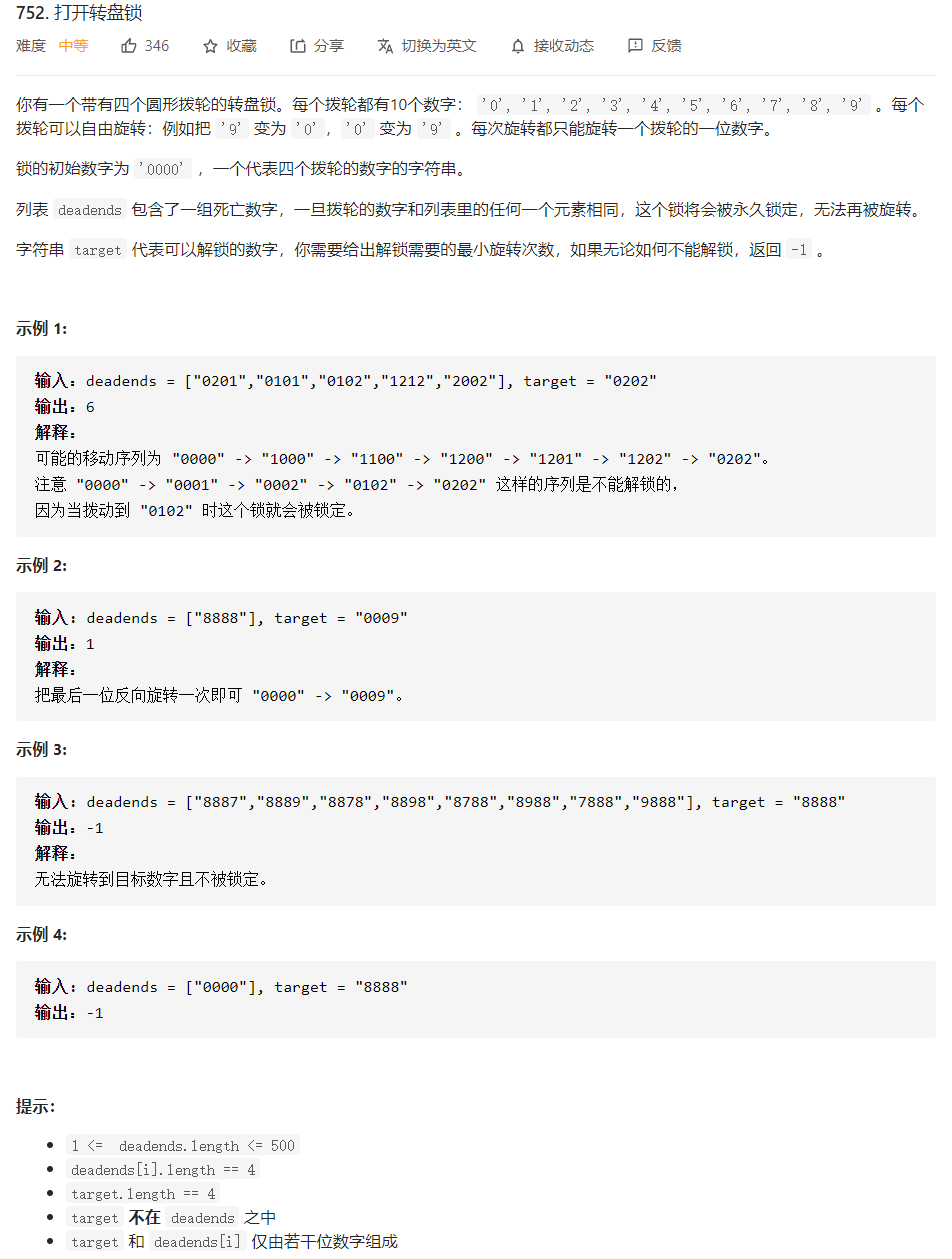
题目分析
这个题目是我非常推荐小伙伴们去做的一个题目,这个题目会做以后,BFS的类似题目应该都可以顺利求解
广度优先搜索
关于BFS的基本操作前面已经有大量的讲解和练习,这里不做过多介绍。推荐本题的原因是,这个题目包含了多次优化思想,虽然不能从理论上降低时间复杂度,但是这些剪枝操作在实际的测试样例中会节约大量的时间。
使用双向BFS进行求解,我们都知道BFS的时间复杂度为指数量级,对于m叉树来说为$O(m^n)$。因为每次都会扩展m倍的数据量。初始queue队列中仅有初始状态,第一次循环结束,初始状态弹出,会压入m个状态1,第二次循环结束,m个状态1弹出,会压入$m^2$个状态2,依此类推。所以我们要尽量减少n。本题中,一次解锁,可能产生8个状态,m = 8,极端情况下,target = “55555”,因此需要解锁20次,所以运算量为$8^20$,这是一个非常大的数。但是本题我们仅仅要搜索到target即可,在最后一次循环中,仅仅需要一个状态,因此我们可以从两端向中间搜索,从”0000”向target搜索一个循环,然后再从target向”0000”搜索一个循环,这样相当于将n减少为一半,此时运算量为$8^10$,这就极大降低了运行时间。
使用哈希表记录已经遍历过的状态,根据思路1选择了双向BFS,记从”0000”到target的队列为begin_queue,从target到”0000”的队列记为”end_queue”。从”0000”到target的寻找过程中,如果某个状态曾经出现过,可以停止搜索,因此使用begin_visited哈希表记录正向搜索过程中已经出现的状态。反向同理。这样状态最多出现$10^4$个,即从”0000”到”9999”,这种剪枝是最有效和常用的方法。往往可以将时间复杂度从指数降为线性。
第三种优化思路需要和第一种与第二种思路搭配使用,在双向BFS中,使用begin_visited和end_visited记录曾经遍历过的状态,当正向搜索时,某个状态K出现在end_visited中,说明找到了一条从”0000”到k和从target到k的通路,此时就可以直接返回当前的迭代次数,反向搜索同理
算法的**时间复杂度为$O(m^n \times n^2)$,空间复杂度为$O(m^n \times n)$**,其中m=10为转盘数字的进制,n=4为转盘数字的位数。
下面是C++语言的题解
1 | class Solution { |
下面是Python语言的题解
1 | class Solution: |
对比C++和Python两种语言,可以发现Python语言中,函数中可以嵌套定义函数,非常方便,在C++语言中函数无法嵌套定义,但是可以使用lambda表达式进行类似的操作。而且要注意的是在C++语言中,本层遍历后beginQueue要指向newBeginQueue,此时两个都应该设置为指针,否则newBeginQueue结束清空时,beginQueue也为空。而Python里面对象都是指针,因此直接赋值即可。
刷题总结
本题的重点在于双向BFS的优化,而且小伙伴们一定要区分什么时候用BFS,什么时候用DFS,通常来说两个都可以使用,当求最短路的时候,要使用BFS,因为每一次循环代表往前进一步,第一次搜索到某个状态时,一定是最短的路径,这时如果使用DFS则需要将所有的通路都走一遍,才能找到最短的路径。当题目只需要寻找到一条通路时,往往使用DFS,因为BFS每次前进一步,假设最近为第n步,时间复杂度为$O(m^n)$,而且需要耗费$O(m^n)$的空间复杂度。但是使用DFS,可能第一次就找到通路,计算量为$O(n)$,空间复杂度为$O(n)$,表示栈空间的调用。